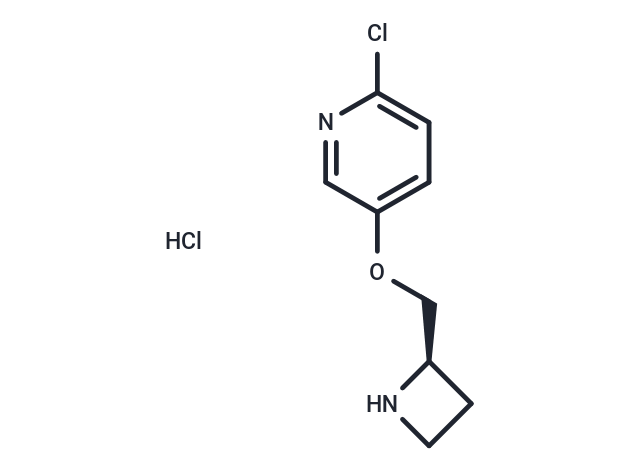Shopping Cart
- Remove All
 Your shopping cart is currently empty
Your shopping cart is currently empty

Tebanicline hydrochloride (Ebanicline hydrochloride) , is an effective synthetic nicotinic (non-opioid) analgesic drug.

| Pack Size | Price | Availability | Quantity |
|---|---|---|---|
| 1 mg | $37 | In Stock | |
| 2 mg | $51 | In Stock | |
| 5 mg | $91 | In Stock | |
| 10 mg | $141 | In Stock | |
| 25 mg | $277 | In Stock | |
| 50 mg | $498 | In Stock | |
| 100 mg | $725 | In Stock | |
| 500 mg | $1,520 | In Stock |
| Description | Tebanicline hydrochloride (Ebanicline hydrochloride) , is an effective synthetic nicotinic (non-opioid) analgesic drug. |
| Targets&IC50 | nAChR:37 pM(ki) |
| In vitro | Tebanicline is a novel, potent cholinergic nAChR ligand with analgesic properties that shows preferential selectivity for neuronal nAChRs. It inhibits the binding of cytisine to α4β2 neuronal nAChRs with a Ki of 37 pM. Functionally, tebanicline is an agonist. At the transfected human α4β2 neuronal nAChR in K177 cells, with increased 86Rb+ efflux as a measure of cation efflux, ABT-594 has an EC50 value of 140 nM with an intrinsic activitycompared with (?)-nicotine of 130%; at the nAChR subtype expressed in IMR-32 cells, an EC50 of 340 nM; at the F11 dorsal root ganglion cell line, an EC50 of 1220 nM; and via direct measurement of ion currents, an EC50 value of 56,000 nM at the human α7 homo-oligimeric nAChR produced in oocytes[1] |
| In vivo | Tebanicline is a potent antinociceptive agent with full efficacy in models of acute and persistent pain and that these effects are mediated predominately by an action at central neuronal nAChRs[2]. Tebanicline produces significant antinociceptive effects in mice against both acute noxious thermal stimulation. ABT-594 is orally active, but 10-fold less potent by this route than after i.p. administration. The antinociceptive effect of ABT-594 is prevented, but not reversed, by the noncompetitive neuronal nicotinic acetylcholine receptor antagonist[3]. Tebanicline has antinociceptive effects in rat models of acute thermal, persistent chemical, and neuropathic pain. Direct injection of tebanicline into the nucleus raphe magnus (NRM) is antinociceptive in a thermal threshold test and destruction of serotonergic neurons in the NRM attenuates the effect of systemic tebanicline[4]. |
| Alias | Ebanicline hydrochloride, ABT-594 hydrochloride |
| Molecular Weight | 235.11 |
| Formula | C9H12Cl2N2O |
| Cas No. | 203564-54-9 |
| Smiles | Cl.Clc1ccc(OC[C@H]2CCN2)cn1 |
| Relative Density. | no data available |
| Storage | Powder: -20°C for 3 years | In solvent: -80°C for 1 year | Shipping with blue ice. | |||||||||||||||||||||||||||||||||||
| Solubility Information | DMSO: 50 mg/mL (212.67 mM), Sonication is recommended. | |||||||||||||||||||||||||||||||||||
Solution Preparation Table | ||||||||||||||||||||||||||||||||||||
DMSO
| ||||||||||||||||||||||||||||||||||||

Copyright © 2015-2025 TargetMol Chemicals Inc. All Rights Reserved.